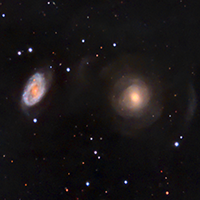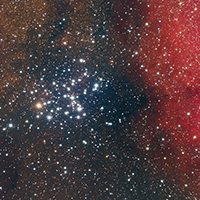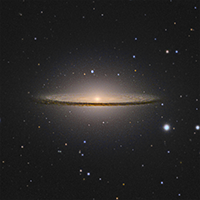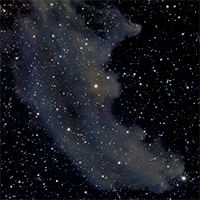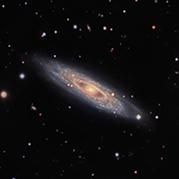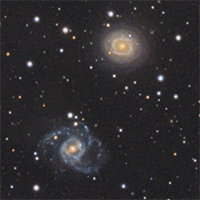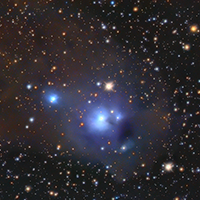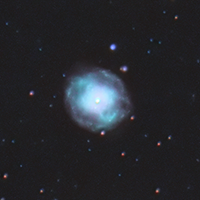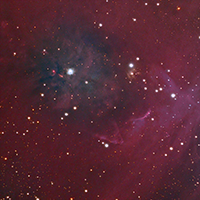Tagged: NGC
23-Nov-2019
The Sculptor Galaxy, also known as the Silver Coin or Silver Dollar Galaxy, NGC 253, is an intermediate spiral galaxy in the constellation Sculptor. The Sculptor Galaxy is a starburst galaxy, which means that it is currently undergoing a period of intense star formation.
07-Nov-2019
Perhaps too tough of a target for light polluted skies, elliptical galaxy NGC 474 still managed to show some tidal tails / shells from interacting with the nearby spiral galaxy NGC 470.
07-Jul-2019
The Butterfly Cluster, Messier 6, is an open cluster of hot blue stars with the brightest member being an orange giant star. Behind the cluster is the orange light of the Milky Way, and a beautiful cloud of excited Hydrogen alpha gas.
25-Apr-2019
The Sombrero Galaxy (also known as Messier Object 104, M104 or NGC 4594) is a lenticular galaxy in the constellation Virgo found 31 million light-years from Earth.
11-Apr-2019
IC 2118 (also known as Witch Head Nebula due to its shape) is an extremely faint reflection nebula believed to be an ancient supernova remnant or gas cloud illuminated by nearby supergiant star Rigel in the constellation of Orion.
12-Feb-2019
The Skull & Crossbones Nebula is an active star-forming region approximately 20,000 light years away.
16-Nov-2018
Seen face-on, this large spiral galaxy is 70 million light years away, with a bright core and very faint blue arms. A companion elliptical galaxy seems to be interacting with a spiral arm.
11-Sep-2018
NGC 7184 is a barred spiral galaxy 114 million light years from Earth.
17-Aug-2018
NGC6935 and NGC6937 are two differing spiral galaxies that appear close to each other, though they are not gravitationally bound
30-Jul-2018
NGC 6902 is a spiral galaxy 33 million light years away in the Sagittarius constellation. It has a very bright center, with grand spiral arms extending out much further than the local light pollution allowed me to see.
25-Apr-2018
NGC5367 is a reflection nebula 2000 light years in the Centaurus constellation. The bright blue stars illuminate the otherwise dark molecular cloud complex.
18-Apr-2018
NGC4361 is a planetary nebula with spiral arms similar to a galaxy. The star at the center of the nebula is shedding its outer layers while contracting to form a white dwarf.
16-Feb-2018
NGC2835 is a small, faint spiral galaxy in the Hydra constellation. This is a test shot through a newly acquired GSO RC8 carbon fibre astrograph.
08-Jan-2018
NGC 1999 is a dusty blue reflection nebula, embedded in the hydrogen dust cloud of Orion. This narrow band enhanced image shows the light blue NGC 1999 at the center, with the edge of M42 (the Orion Nebula) at the far right. Also shown in the image is the waterfall nebula, the magenta shock wave between NGC 1999 and M42.
11-Aug-2017
After a brief hiatus from astronomy to build a new, larger observatory, I've chosen another difficult target that was surprisingly bright.

